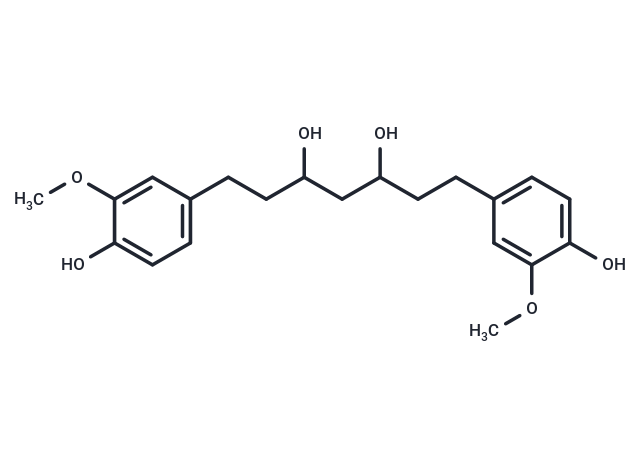Shopping Cart
- Remove All
 Your shopping cart is currently empty
Your shopping cart is currently empty

Octahydrocurcumin has antioxidant and and anti-inflammatory activities, it can inhibit the lipopolysaccharide (LPS)-induced inflammatory response via the mechanism of inhibiting NF-kB translocation to the nucleus. Octahydrocurcumin exhibits potent cytotoxic effect (IC50 =19.46 ug/mL) and shows high antimicrobial activity.

| Pack Size | Price | Availability | Quantity |
|---|---|---|---|
| 1 mg | $42 | In Stock | |
| 5 mg | $98 | In Stock | |
| 10 mg | $158 | In Stock | |
| 25 mg | $289 | In Stock | |
| 50 mg | $433 | In Stock | |
| 1 mL x 10 mM (in DMSO) | $108 | In Stock |
| Description | Octahydrocurcumin has antioxidant and and anti-inflammatory activities, it can inhibit the lipopolysaccharide (LPS)-induced inflammatory response via the mechanism of inhibiting NF-kB translocation to the nucleus. Octahydrocurcumin exhibits potent cytotoxic effect (IC50 =19.46 ug/mL) and shows high antimicrobial activity. |
| In vitro | OKT3-induced PBMC proliferation was inhibited by curcumin, isocurcumin, bisdesmethoxy-, diacetyl-, tetrahydro-, hexahydro-, and octahydrocurcumin as well as by vanillin, ferulic acid, and dihydroferulic acid with IC50-values of 2.8, 2.8, 6.4, 1.0, 25, 38, 82, 729, 457, and >1,000?μM, respectively. The investigated substances with the strongest effect on radical scavenging were tetrahydro-, hexahydro-, and octahydrocurcumin with IC50?values of 10.0, 11.7, and 12.3?μM, respectively. IC50-values of dihydroferulic acid, ferulic acid, and curcumin were 19.5, 37, and 40?μM. The substances with the lowest radical scavenging activities were vanillin, isocurcumin, diacetylcurcumin, and bisdesmethoxycurcumin with IC50?values higher than 100?μM each[1]. |
| Molecular Weight | 376.44 |
| Formula | C21H28O6 |
| Cas No. | 36062-07-4 |
| Smiles | COc1cc(CCC(O)CC(O)CCc2ccc(O)c(OC)c2)ccc1O |
| Relative Density. | 1.23g/cm3 |
| Storage | Powder: -20°C for 3 years | In solvent: -80°C for 1 year | Shipping with blue ice. | ||||||||||||||||||||||||||||||||||||||||
| Solubility Information | Ethanol: 10 mg/mL (26.56 mM), Sonication is recommended. DMSO: 100 mg/mL (265.65 mM), Sonication is recommended. | ||||||||||||||||||||||||||||||||||||||||
Solution Preparation Table | |||||||||||||||||||||||||||||||||||||||||
Ethanol/DMSO
DMSO
| |||||||||||||||||||||||||||||||||||||||||

Copyright © 2015-2025 TargetMol Chemicals Inc. All Rights Reserved.